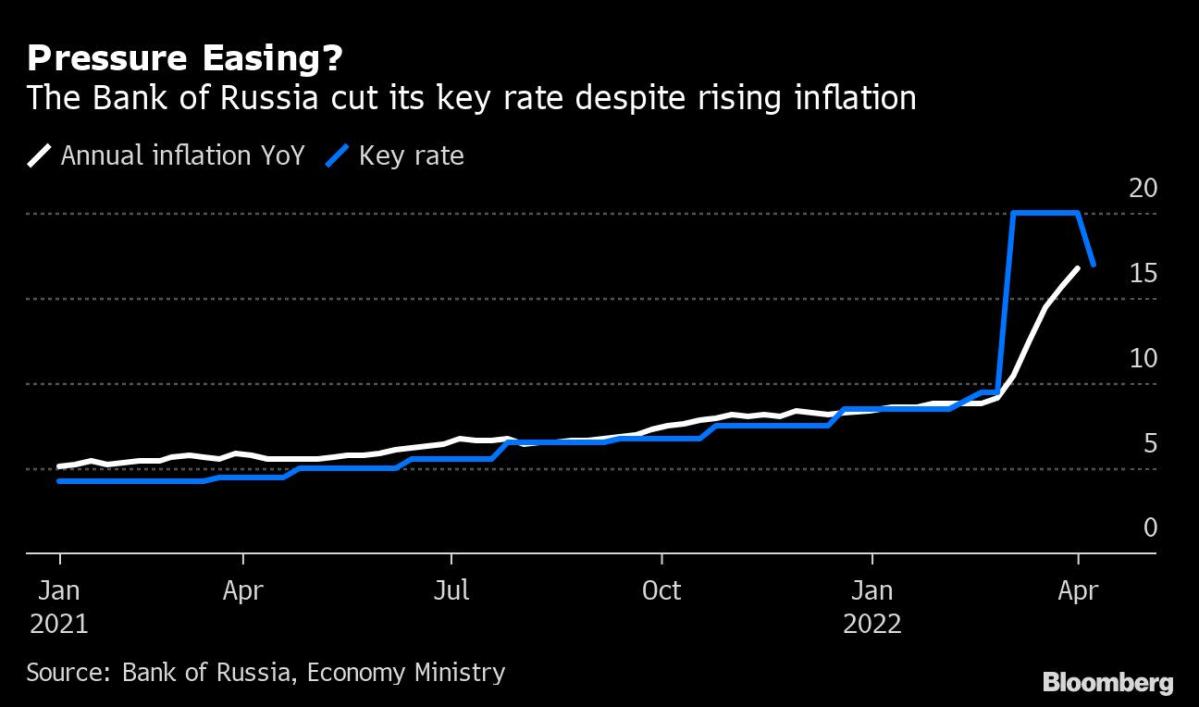Russia Unexpectedly Slashes Rates as Focus Pivots to Economy

(Bloomberg) — Russia’s central bank unexpectedly slashed its key interest rate in a sign of confidence that the worst of the financial turmoil triggered by the invasion of Ukraine is past.
Most Read from Bloomberg
Reversing part of the steep rate increase delivered after the attack, the central bank lowered the benchmark to 17% from 20% at an unscheduled meeting on Friday and said further cuts could be made in the months ahead if conditions permit. The ruble briefly halted its rebound against the dollar after the decision before surging again.
“The central bank wants to be a locomotive of the economic rebound, not a brake,” said Luis Saenz, head of international distribution at Sinara.
Sweeping international sanctions have touched off inflation and put the world’s biggest energy exporter on track for a deep, two-year recession while pushing the Russian government to the edge of default.
But continuing inflows of energy revenues and tough capital controls — including a ban on foreigners selling Russian assets as well as mandated hard currency sales by exporters — have helped the ruble regain ground.
“External conditions for the Russian economy are still challenging, considerably constraining economic activity,” the central bank said in a statement. “Financial stability risks are still present, but have ceased to increase for the time being, including owing to the adopted capital control measures.”
It’s a policy pivot that echoes Governor Elvira Nabiullina’s surprise 200 basis-point rate cut in 2015, which reversed an emergency hike made weeks earlier. At the time, Russia was entering an economic contraction following the first round of sanctions over Ukraine and the collapse in oil prices.
Russia’s currency briefly erased gains after the rate cut, before resuming its advance and surging 6.2% to 71.3375 per dollar as of 3:30 p.m. In Moscow. Yields on Russia’s 10-year local debt tumbled more than a percentage point to 10.98%
The ruble on Wednesday advanced past 81.16 in Moscow trading, the level it closed at on Feb. 23 — the day before President Vladimir Putin launched his attack.
“The ruble is very strong,” said Natalia Orlova, economist at Alfa-Bank. “This reduces the horizon of inflation risks.”
Nabiullina acted three weeks before a scheduled rate meeting, as pressure builds against Russia in response to reports that the country’s forces committed apparent war crimes in Ukraine. On Friday, Japan announced it will ban imports of Russian coal, a day after a similar decision by the European Union.
The Group of Seven leaders issued a statement saying that the countries will ban new investment into Russia’s energy sector and expand trade restrictions, including phasing out and banning coal imports.
Still, weekly inflation has shown signs of decelerating, a slowdown the central bank said can in part be attributed to a stronger ruble, and fears faded over a possible run on the lenders. With this, room has opened for some monetary easing.
“Risks of financial instability have stopped rising or even started to decline,” Igor Rapokhin, senior strategist at SberCIB Investment Research. “If the situation continues to develop in a similar way, then by the end of the year the key rate may be reduced to 10%.””
Most Read from Bloomberg Businessweek
©2022 Bloomberg L.P.




